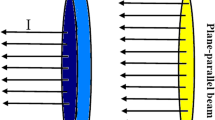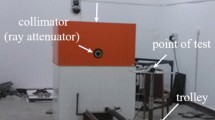Abstract
Protection in industrial radiography facilities has been a worldwide concern for decades and the most appropriate protection for the public and operators in small scale facilities is the engineering protection including shielding first, time and distance. Monte Carlo methods were used for thickness determination in shielding design for gamma imaging using gamma sources in fixed facilities. Computation was done to develop the concrete design that can slow down the effective dose rate of the gamma rays from 100 Ci (or less) of Co-60 and 50 Ci (or less) of Ir-192 less than the value of 2.5 μSv/h (the limit for Public area) as required by the ALARA principle and regulation of different countries. The minimum concrete wall thickness necessary to achieve the ALARA principle in the previous conditions was found to be 120 cm for Co-60 source and 70 cm for the Ir-192 source. From the optimized design using a single corner maze, it was found that the central source position gives rise to high exposure and should not be used as a source position. Only the left and right positions of the source are preferred depending on the facility’s dimensions. For Co-60 with a maze corridor less than 7 m, the right position of the source is the most appropriate while the left position is preferred for larger dimensions. For Ir-192, the right position if preferred if the corridor length is less than 5 m and the left otherwise. Double-corner maze design was found to be the most appropriate shielding design for gamma radiation with the left and right position of the sources the best for both sources used. The double-corner maze required only 4 m maze length to achieve 2.5 µSv/h or less ALARA principle while single corner design requires 12 m or 14 m for left and right positions, respectively.
Graphic abstract


















Similar content being viewed by others
References
B. Aygün, High alloyed new stainless steel shielding material for gamma and fast neutron radiation. Nucl. Eng. Technol. 52(3), 647–653 (2020). https://doi.org/10.1016/j.net.2019.08.017
C.J. Guembou Shouop, S.I. Bak, M. Ndontchueng Moyo et al., New Cf-252 neutron source shielding design based Monte Carlo simulation using material combination. AIP Adv. (2020). https://doi.org/10.1063/1.5144923
A. Khorshidi, H. H. Behzad Khosrowpour, Determination of defect depth in industrial radiography imaging using MCNP code and SuperMC software. Nucl. Eng. Technol. 2019. (in press)
J.C. Rockley, Industrial radiography. Electron. Power (1977). https://doi.org/10.1049/ep.1977.0176
T. Senda, Radiographic testing. Yosetsu Gakkai Shi/J. Jpn. Weld. Soc. (1975). https://doi.org/10.2207/qjjws1943.44.4_278
D. Saengchantr, S. Srisatit, N. Chankow, Development of gamma ray scanning coupled with computed tomographic technique to inspect a broken pipe structure inside laboratory scale vessel. Nucl. Eng. Technol. 51, 800–806 (2018)
H.S. Mann, G.S. Brar, K.S. Mann, G.S. Mudahar, Experimental investigation of clay fly ash bricks for gamma-ray shielding. Nucl. Eng. Technol. 48, 1230–1236 (2016). https://doi.org/10.1016/j.net.2016.04.001
R.A. Ramadhan, K.M.S. Abdullah, Background reduction by Cu/Pb shielding and efficiency study of NaI(TI) detector. Nucl. Eng. Technol. 50, 462–469 (2018). https://doi.org/10.1016/j.net.2017.12.016
R. Bagheri, A. Khorrami Moghaddam, H. Yousefnia, Gamma ray shielding study of barium–bismuth–borosilicate glasses as transparent shielding materials using MCNP-4C Code, XCOM program, and available experimental data. Nucl. Eng. Technol. 49, 216–223 (2017)
K.S. Mann, γ-Ray shielding behaviors of some nuclear engineering materials. Nucl. Eng. Technol. 49, 792–800 (2017). https://doi.org/10.1016/j.net.2016.12.016
D.W. Lim, C.W. Lee, J.Y. Lim, D. Hartanto, On the particle swarm optimization of cask shielding design for a prototype sodium-cooled fast reactor. Nucl. Eng. Technol. 51, 284–292 (2019). https://doi.org/10.1016/j.net.2018.09.007
S.A.M. Issa, H.O. Tekin, R. Elsaman et al., Radiation shielding and mechanical properties of Al2O3–Na2O–B2O3–Bi2O3 glasses using MCNPX Monte Carlo code. Mater. Chem. Phys. 223, 209–219 (2019). https://doi.org/10.1016/j.matchemphys.2018.10.064
G. Hu, H. Hu, Q. Yang, B. Yu, W. Sun, Study on the design and experimental verification of multilayer radiation shield against mixed neutrons and γ-rays. Nucl. Eng. Technol. 52(1), 178–184 (2017). https://doi.org/10.1016/j.net.2019.07.016
Y.L. Qun, L.Y. Kuo, P.M. Jun et al., A fast gamma-ray dose rate assessment method for complex geometries based on stylized model reconstruction. Nucl. Eng. Technol. 51, 1436–1443 (2019). https://doi.org/10.1016/j.net.2019.03.004
O. Agar, M.I. Sayyed, F. Akman et al., An extensive investigation on gamma ray shielding features of Pd/Ag-based alloys. Nucl. Eng. Technol. 51, 853–859 (2019). https://doi.org/10.1016/j.net.2018.12.014
AGENCY IAE, Radiation Protection and Safety in Industrial Radiography (IAEA 1999) Safety Reports Series No. 13. Vienna (1999)
K. Coeytaux, E. Bey, D. Christensen et al., Reported radiation overexposure accidents worldwide, 1980–2013: a systematic review. PLoS ONE 10, 1–26 (2015). https://doi.org/10.1371/journal.pone.0118709
P. Ortiz, M. Oresegun, J. Wheatley, Lessons from Major Radiation Accidents. in Proceedings of 10th International Congress of the International Radiation Protection Association (2000)
C.J. Guembou Shouop, M. Ndontchueng Moyo, E.J. Nguelem Mekongtso et al., Radiological protection requirements with regard to cosmic ray exposure during air travel. Eur. Phys. J. Plus 123, 1–21 (2020). https://doi.org/10.1140/epjp/s13360-020-00468-8
Nuclear Laws of the Republic of Korea, Regulations on Technical Standards for Radiation (2019)
T. Sato, Y. Iwamoto, S. Hashimoto et al., Features of particle and heavy ion transport code system (PHITS) version 3.02. J. Nucl. Sci. Technol. (2018). https://doi.org/10.1080/00223131.2017.1419890
K. Niita, T. Sato, H. Iwase et al., PHITS-a particle and heavy ion transport code system. Radiat. Meas. (2006). https://doi.org/10.1016/j.radmeas.2006.07.013
T. Sato, K. Niita, N. Matsuda et al., Overview of particle and heavy ion transport code system PHITS. Ann. Nucl. Energy (2015). https://doi.org/10.1016/j.anucene.2014.08.023
T. Sato, K. Niita, N. Matsuda et al., Overview of the PHITS code and its application to medical physics. Prog. Nucl. Sci. Technol. (2014). https://doi.org/10.15669/pnst.4.879
K. Niita, N. Matsuda, Y. Iwamoto, et al., PHITS overview. in AIP Conference Proceedings (2007)
A. Endo, Y. Yamaguchi, K.F. Eckerman, Nuclear Decay Data for Dosimetry Calculations: Revised Data of ICRP Publication 38. Supplement (2005)
CNSC, REGDOC-2.5.5: Design of Industrial Radiography Installations. in Canadian Nuclear Safety Commission (2019)
C.J. Guembou Shouop, Shielding Design and Safety Measures Around 60Co, 192Ir, and 252Cf Sources in Industrial Radiography Facilities Based on Phits Monte Carlo Simulations (KAIST—Korea Advanced Institute of Science and Technology, Daejeon, 2020)
C.J. Guembou Shouop, S. Bak (2019) Maze influence to radiological protection around industrial radiographic sources (Co-60) under 100 Ci. in Transactions of the Korean Nuclear Society Autumn Meeting Goyang, Korea, October 24–25 (2019), pp. 3–6
G. Shouop, C. Joel, N.M. Maurice et al., Monte Carlo method for gamma spectrometry based on GEANT4 toolkit: efficiency calibration of BE6530 detector. J. Environ. Radioact. 189, 109–119 (2018). https://doi.org/10.1016/j.jenvrad.2018.03.015
J. Allison, K. Amako, J. Apostolakis et al., Geant4 developments and applications. IEEE Trans. Nucl. Sci. (2006). https://doi.org/10.1109/TNS.2006.869826
T. Sato, K. Niita, N. Matsuda et al., Particle and heavy ion transport code system, PHITS, version 2.52. J. Nucl. Sci. Technol. (2013). https://doi.org/10.1080/00223131.2013.814553
Penelope, A Code System for Monte Carlo Simulation of Electron and Photon Transport. in Workshop Proceedings Issy-les-Moulineaux, France, 5 − 7 November, AEN-NEA (2001)
N. Metropolis, The beginning of the Monte Carlo method. Los Alamos Sci. (1987 Spec. Issue Dedic. to Stanislaw Ulam) (1987)
Acknowledgements
The authors are grateful to PHITS Collaboration (T. Sato, S. Hashimoto, K. Niita, et al.) for PHITS development, to Korea Advanced Institute of Science and Technology – KAIST, NQE Department (Y. Kim, J. Park, C.M. Choi, et al.) for code license, and to Korea Institute of Nuclear Safety – KINS (Computer Lab). They want to extent their gratitude to the National Radiation protection Agency of Cameroon – NRPA (A. Simo, M. Moyo, E.J. Nguelem, et al.) for administrative and technical support during the journey in KAIST. The authors extended their gratitude to the editorial team of EPJ Plus for their positive and constructive criticism.
Author information
Authors and Affiliations
Corresponding author
Rights and permissions
About this article
Cite this article
Guembou Shouop, C.J., Sang-In, B. Shielding design for high-intensity Co-60 and Ir-192 gamma sources used in industrial radiography based on PHITS Monte Carlo simulations. Eur. Phys. J. Plus 135, 784 (2020). https://doi.org/10.1140/epjp/s13360-020-00797-8
Received:
Accepted:
Published:
DOI: https://doi.org/10.1140/epjp/s13360-020-00797-8




